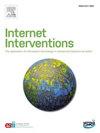The therapeutic alliance in blended versus face-to-face cognitive behavioral therapy for adolescents and young adults with a depressive disorder
IF 4.1
2区 医学
Q1 HEALTH CARE SCIENCES & SERVICES
Internet Interventions-The Application of Information Technology in Mental and Behavioural Health
Pub Date : 2024-09-14
DOI:10.1016/j.invent.2024.100776
引用次数: 0
Abstract
Introduction
A depressive disorder during adolescence is a serious and disabling disorder, which has a high impact on the development of adolescents. Blended treatment, combining online and face-to-face sessions, is effective and can reduce some of the barriers for adolescents to use mental health care. There is a lack of knowledge about whether therapeutic alliance is established in blended treatment for adolescents and young adults suffering from a depressive disorder. This study examines whether the quality of the therapeutic alliance differs when cognitive behavior therapy (CBT) is delivered in combination with online intervention (b-CBT) compared to solely face-to-face (FtF-CBT) and the extent to which a stronger therapeutic alliance is associated with better treatment outcome.
Methods
A pragmatic quasi-experimental design was used. Data collected within two separate studies were combined. A total of 85 participants (80 % female), aged 13–22 (mean = 16.63, SD = 1.92) were recruited within mental health care institutions and diagnosed with a depressive disorder (using K-SADS). Assessments were done at pre-treatment (T0), after five weeks (T1), after ten weeks (T2), post-treatment (T3) and one to four weeks after treatment (T4) and included measures of depressive symptomatology (CDI-2). The therapeutic alliance was measured at T1, T2 and T3 by the TASC. t-tests for independent samples were used to test differences in therapeutic alliance rates between b-CBT and FtF-CBT at post-treatment. A linear growth model for depressive symptoms based on five time points with Latent Growth Curve Analysis (LGCA) was used to test whether the therapeutic alliance is associated with depressive symptoms.
Results
No differences in therapeutic alliance between b-CBT and FtF-CBT were found on either client-rated or therapist-rated therapeutic alliance. For both intervention groups, no significant association between the therapeutic alliance and depressive outcome was found.
Discussion
This study shows that providing part of CBT using an online environment does not have a negative impact on the therapeutic alliance. In contrast to earlier research, no association was found between the therapeutic alliance and therapy outcome in neither the b-CBT nor the FtF-CBT intervention.
针对患有抑郁障碍的青少年的混合认知行为疗法与面对面认知行为疗法中的治疗联盟
导言 青少年时期的抑郁障碍是一种严重的致残性障碍,对青少年的成长有很大影响。将在线治疗和面对面治疗相结合的混合治疗是有效的,可以减少青少年使用心理健康护理的一些障碍。对于青少年和年轻成年人抑郁障碍患者在混合治疗中是否建立了治疗联盟还缺乏了解。本研究探讨了在认知行为疗法(CBT)与在线干预(b-CBT)相结合的情况下,治疗联盟的质量与单纯的面对面治疗(FtF-CBT)相比是否有所不同,以及更强的治疗联盟在多大程度上与更好的治疗效果相关。研究采用了务实的准实验设计,将两项独立研究中收集的数据进行了合并。共有 85 名参与者(80% 为女性),年龄在 13-22 岁之间(平均值 = 16.63,标准差 = 1.92),均在精神医疗机构中招募,并被诊断为抑郁障碍(使用 K-SADS)。评估在治疗前(T0)、五周后(T1)、十周后(T2)、治疗后(T3)和治疗后一至四周(T4)进行,包括抑郁症状测量(CDI-2)。治疗联盟在 T1、T2 和 T3 阶段通过 TASC 进行测量。独立样本 t 检验用于检验治疗后 b-CBT 和 FtF-CBT 治疗联盟率的差异。使用基于五个时间点的抑郁症状线性增长模型和潜伏增长曲线分析法(LGCA)来检验治疗联盟是否与抑郁症状相关。结果无论是在客户评分还是治疗师评分的治疗联盟方面,b-CBT 和 FtF-CBT 之间都没有发现治疗联盟的差异。本研究表明,使用在线环境提供部分 CBT 不会对治疗联盟产生负面影响。与之前的研究不同的是,在 b-CBT 和 FtF-CBT 干预中均未发现治疗联盟与治疗结果之间存在关联。
本文章由计算机程序翻译,如有差异,请以英文原文为准。
求助全文
约1分钟内获得全文
求助全文
来源期刊

Internet Interventions-The Application of Information Technology in Mental and Behavioural Health
Medicine-Health Informatics
CiteScore
6.50
自引率
9.30%
发文量
94
审稿时长
6 weeks
期刊介绍:
Official Journal of the European Society for Research on Internet Interventions (ESRII) and the International Society for Research on Internet Interventions (ISRII).
The aim of Internet Interventions is to publish scientific, peer-reviewed, high-impact research on Internet interventions and related areas.
Internet Interventions welcomes papers on the following subjects:
• Intervention studies targeting the promotion of mental health and featuring the Internet and/or technologies using the Internet as an underlying technology, e.g. computers, smartphone devices, tablets, sensors
• Implementation and dissemination of Internet interventions
• Integration of Internet interventions into existing systems of care
• Descriptions of development and deployment infrastructures
• Internet intervention methodology and theory papers
• Internet-based epidemiology
• Descriptions of new Internet-based technologies and experiments with clinical applications
• Economics of internet interventions (cost-effectiveness)
• Health care policy and Internet interventions
• The role of culture in Internet intervention
• Internet psychometrics
• Ethical issues pertaining to Internet interventions and measurements
• Human-computer interaction and usability research with clinical implications
• Systematic reviews and meta-analysis on Internet interventions
 求助内容:
求助内容: 应助结果提醒方式:
应助结果提醒方式:


